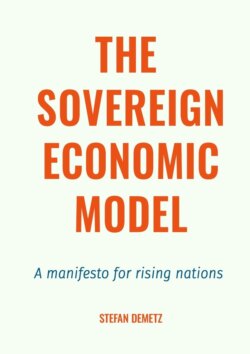Читать книгу The Sovereign Economic Model. A manifesto for rising nations - Stefan Demetz - Страница 12
Politics of the sovereign economic model
The Competitive Advantages of Nations
ОглавлениеIn the past, cities, trading posts, fortifications, and ports were built in strategic geographic locations for trading, security, safety, and easy access to natural resources like water and fertile land. Cities were erected near rivers and cultivable land, fortifications on easily defensible hills and mountaintops, trading posts on bustling trading routes or near production areas, and ports in defensible bays with quiet, protected waters. These strategic locations are constantly contested by many countries for military and trading advantages. Many countries still enjoy competitive advantages given by geography and have adapted their economies to take advantage of that. Therefore, most countries have some sort of advantage over others in certain categories of goods. Most times, this advantage has been built upon to create extensive economic activity and even advanced industries. Some industries have ended for various reasons, such as replacement by newer technologies or simply finite resources. It is in the interest of countries to identify such competitive advantages and build on them. They may be simple things like water, large land surfaces, or natural resources. These sectors should constitute the foundation of an economy. Catalysts to economic development are categorized into two macro groups:
• Naturally occurring competitive advantages
• Evolutionary development from agriculture, natural resources, and infrastructure
Natural competitive advantages should be used for evolutionary economic development. Once competitive advantages have been identified, both historical and new ones, the focus should be to take advantage of them by progressing and innovating to achieve quick evolutionary developments. As a base, agriculture, natural resources, and infrastructure are used to improve the economy. Even at a basic level, because they require tremendous manual input, these sectors need automation and innovation by machines, tools, materials, and technologies. The footprint of such primary goods and activity is unusually large, and there are huge margins to start production of capital goods as a part of import substitution programs. This brings a considerable drive to upgrade a country’s skills and industrialization and affects many sectors. Agriculture and food production require a vast variety of machines and industrial processes to convert raw agricultural products into tradeable goods with added value. Natural resources require many large industrial machines to transport, filter, and process raw material extracted from underground. Infrastructure, beyond the construction stages, needs machines and vehicles to transport people and goods, so it is an excellent starting point for heavy industry.
Moreover, all three «basic» industries of agriculture, natural resources, and infrastructure impact other industries, such as the chemical industry, because they require hundreds or thousands of substances for processing. A key government task is to identify the most critical or convenient industries and goods to bet on by considering their benefits to the economy. A government must assess the nation’s industrial and technological capabilities and skills, internal demand, competitiveness, exportability, and a variety of other economic and strategic factors. Once this analysis is done, a country can plan the next steps of its economic development evolution.
